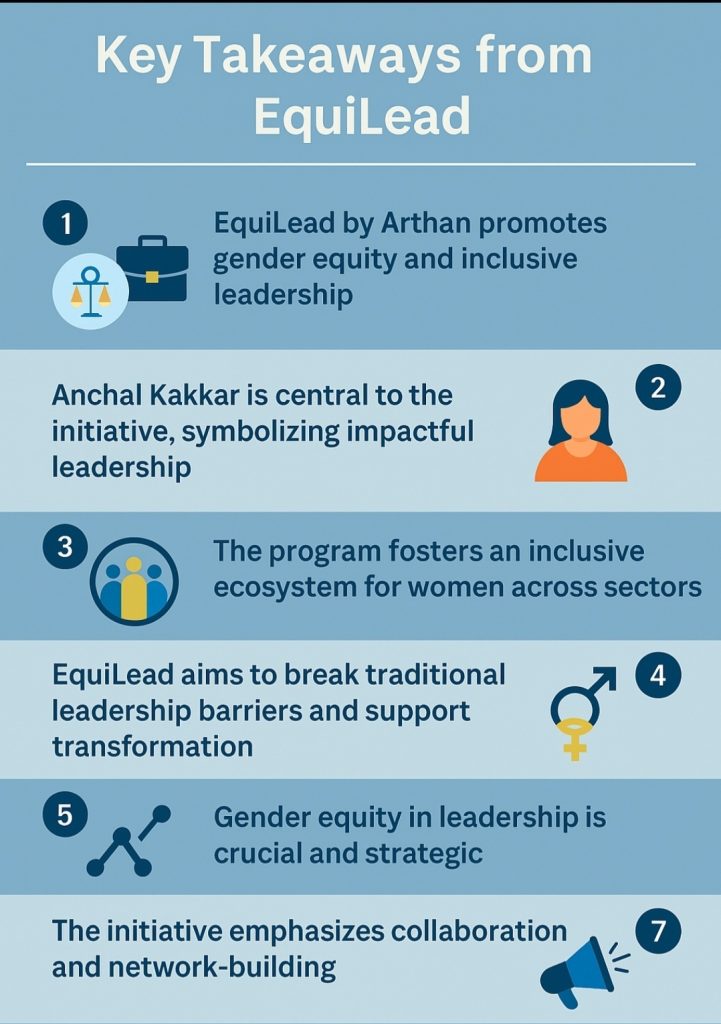At CXQuest, we believe that inclusive leadership, equitable practices, and people-centered values form the foundation of exceptional customer experiences—both within organizations and beyond. Today, we are honored to host a conversation with someone from EquiLead who is actively shaping and advocating for these principles across India’s social impact ecosystem.
Meet Anchal Kakkar—a changemaker, a strategist, and a visionary leader committed to reimagining how organizations think about leadership, equity, and inclusion. Since 2016, in fact, Anchal has been at the helm of transformative efforts through Arthan, a platform that has supported over 1,500 social impact organizations, connected with half a million job seekers, and hosted over 100 sector-shaping forums. Her work has helped strengthen organizational effectiveness while keeping the values of inclusivity and equity at the core.
Gender-Equitable Leadership
Most recently, Anchal has taken center stage with EquiLead, an initiative co-founded to champion gender-equitable leadership within the social sector. Backed by Climate Asia Inc. and Arthan Foundation, EquiLead recently launched a groundbreaking report, Unpacking Gender-Equitable Leadership in Organizations, which unearths stark gaps in DEI implementation and offers a practical roadmap for change. With key insights drawn from 128 organizations, the study calls for a shift from performative intent to tangible, systemic reforms that nurture inclusive and equitable workplaces.
Anchal’s experience is as expansive as it is deep—spanning impactful stints at Boston Consulting Group and Dasra, supported by an academic foundation from Said Business School, Oxford. Her ability to bridge the rigor of the corporate world with the empathy and innovation of the social impact space makes her voice uniquely compelling and urgently relevant in today’s conversations on leadership and customer experience.
Anchal, welcome to CXQuest. We’re truly excited to have you with us today. Your work with Arthan and EquiLead is not just important—it’s transformative. In a time when organizations across sectors are grappling with how to operationalize diversity, equity, and inclusion, your insights offer clarity, direction, and above all, hope. Thank you for joining us to explore how gender-equitable leadership can shape not only stronger organizations but also more meaningful and inclusive customer experiences.
Inclusive Leadership and Customer Experience
Q1. How does gender-equitable leadership impact customer experience and business outcomes?
AK: When women are meaningfully represented in leadership, it leads to better outcomes. Our work at EquiLead, as well as various global studies, shows that gender-equitable leadership contributes to stronger team cultures, more collaborative problem-solving, and ultimately, better service delivery. These qualities don’t stay confined within teams: they ripple outward, shaping how organisations interact with customers. A leadership team that values equity and inclusion is more likely to build customer experiences that are thoughtful, accessible, and relevant to diverse audiences.
Q2. Have you seen a direct correlation between workplace inclusivity and improved customer satisfaction? Can you share an example?
AK: Yes, and it often shows up in subtle but powerful ways. In several organisations we have worked with, inclusive leadership, particularly women leaders who prioritise collaboration and empathy, has resulted in programs that are more contextually grounded and responsive to community needs. This naturally translates to higher satisfaction among beneficiaries and stakeholders. One example is from a mid-sized impact organisation, where shifting leadership structures to include more women led to a redesign of their service delivery model, based on co-creation with community members, and resulted in improved uptake and feedback.
Balancing Leadership Diversity
Q3. Many companies focus on customer diversity but overlook leadership diversity. How can organizations balance both?
AK: Diversity at the customer level cannot be fully leveraged if leadership does not reflect it. Organizations need to stop treating leadership diversity and customer diversity as separate priorities. One informs the other. The first step is to institutionalise gender-equity goals at leadership levels: through mentorship pipelines, equitable promotion practices, and deliberate hiring. Then, ensure these perspectives are brought into decision-making spaces, especially when designing customer-facing services.
Q4. How does fostering an inclusive work environment translate into more empathetic and customer-centric service?
AK: When employees feel seen, heard, and supported, they are more attuned to doing the same for others. Inclusive workplaces tend to emphasise listening, co-creation, and shared accountability, all of which mirror what customers expect from modern, ethical organisations. Women leaders, in particular, are more likely to create environments that foster these values, according to our findings. This culture of empathy inevitably reflects in how services are designed, communicated, and delivered.
DEI and CX Strategy Alignment
Q5. What role does DEI play in shaping a customer experience strategy that resonates with diverse audiences?
AK: DEI is not an add-on to customer strategy; it should be the backbone of it. If your internal structures don’t reflect diversity, it is difficult to truly understand the nuances of your customer base. Organisations that embed DEI into how teams are structured, how decisions are made, and how feedback loops function are naturally better positioned to serve diverse audiences meaningfully.
Q6. How can organizations ensure their CX strategies reflect the diverse needs of their customer base?
AK: Start by looking inward. Does your leadership reflect your customer base? Are you drawing on lived experiences in decision-making? Are your feedback mechanisms accessible across different geographies, languages, and communities? These are basic but often overlooked questions. Inclusive strategy begins with inclusive process.
Visible DEI Commitments
Q7. Do you think customers today expect brands to have visible DEI commitments? How does this affect brand loyalty?
AK: Absolutely. DEI is not just a corporate value; it is a customer expectation. Particularly among younger and more socially aware demographics, a visible commitment to DEI is closely tied to trust and loyalty. When customers see organizations making a sincere effort to walk the talk—not just through statements, but through leadership representation, equitable service design, and transparent policies—they are more likely to stay engaged and advocate for the brand.
Q8. How can companies train frontline employees to deliver a more inclusive and equitable customer experience?
AK: Training has to go beyond check-the-box modules. It should be experiential, regular, and rooted in the lived realities of both employees and customers. Organizations must invest in ongoing capacity building that includes gender sensitivity, unconscious bias, and inclusive communication practices. Our study found that only 50% of organizations conduct DEI-focused training. This is a huge gap that needs urgent addressing.
Gender-Equitable Workplaces and Customer-Centric Cultures
Q9. The EquiLead Study highlights that women’s leadership is higher in smaller organizations but drops in larger firms. How does this leadership gap impact decision-making in CX strategies?
AK: Smaller organizations tend to be nimbler and participatory in their leadership approaches, which allows for CX strategies that are grounded in empathy and proximity to communities. As organizations scale, however, hierarchies tend to harden, and male-dominated leadership reasserts itself. This often leads to a disconnect between strategic decisions and on-ground realities. The absence of women in these decision-making roles narrows the lens through which customer experiences are designed and evaluated.
Q10. How can organizations leverage mentorship and sponsorship programs to empower women leaders in CX roles?
AK: Mentorship helps women navigate systemic biases and build confidence, while sponsorship opens doors. Our study shows that structured programs—especially those that connect entry-level women to senior leaders across functions—are critical. It is about visibility, access, and real support. For CX roles, this also means ensuring that women are part of strategic design and customer-facing teams, not just back-end execution.
Bias Impact
Q11. The study mentions “gendered perceptions of leadership.” Do these biases influence how organizations structure or value customer service roles?
AK: Customer service roles are often feminised—seen as ‘softer’ and therefore less strategic. At the same time, leadership in customer strategy is still largely male-dominated. This contradiction reflects underlying biases that devalue relational skills while over-indexing control-based leadership. We need to reframe what leadership looks like, especially in high-impact, customer-facing roles.
Q12. Have you observed differences in how diverse leadership teams approach problem-solving in CX?
AK: Certainly. Diverse leadership teams tend to approach problems more collaboratively and inclusively. We have seen that women leaders, in particular, are more likely to engage stakeholders, build consensus, and factor in long-term implications rather than just short-term fixes. These traits contribute to more resilient and sustainable CX strategies.
Theme 4: Policy & Innovation for Inclusive CX
Embed Inclusivity In Policies
Q13. How can organizations implement policies that embed inclusivity in both employee and customer experiences?
AK: Start with the basics: equal opportunity policies, inclusive hiring practices, flexible work arrangements, and strong grievance redressal systems. Then go deeper, like having gender-neutral care leave, intersectional training, and participatory program design. Embedding inclusivity means ensuring the same values apply across the employee and customer spectrum.
Q14. How can brands build trust with customers from marginalized communities through inclusive service design?
AK: Listen first. Design services in partnership with the communities you serve. Hire from within these communities. Use local languages and culturally relevant channels. Trust is built when people feel seen and respected—not when inclusion is performative, but when it’s embedded in how services are designed, delivered, and improved.
Q15. The study highlights that 50% of organizations don’t conduct DEI-focused capacity-building. How can businesses integrate DEI into CX training programs?
AK: We need to move from intent to investment. DEI must be embedded into CX training—not treated as a separate exercise. That means training frontline staff on unconscious bias, inclusive communication, and conflict resolution, while also equipping managers with tools to track equity metrics and feedback loops.
Q. 16. In what ways can AI and technology help create a more inclusive and accessible CX?
AK: AI can be a powerful enabler—but only if designed consciously. For instance, AI-driven chatbots can support multilingual queries, screen readers can enhance accessibility, and data analytics can identify where exclusion is happening. But tech is only as inclusive as the people building it. So, we must pair innovation with accountability to ensure it truly serves diverse customers.

Closing
Anchal, thank you for such an insightful and thought-provoking conversation. In fact, your ability to weave together data, lived experience, and actionable strategies gives us—and our readers—a powerful lens to reexamine leadership, equity, and their direct impact on how we serve our customers and communities.
Your work through EquiLead is a beacon for organizations striving to move beyond intent into meaningful impact. In fact, we hope this dialogue inspires many more leaders to step up, reframe their strategies, and embed inclusion not just into policies—but into the very heart of how they lead and serve.
We look forward to continuing this conversation and witnessing the ripples your work continues to create in the sector and beyond. Thank you once again for being with us on CXQuest.


